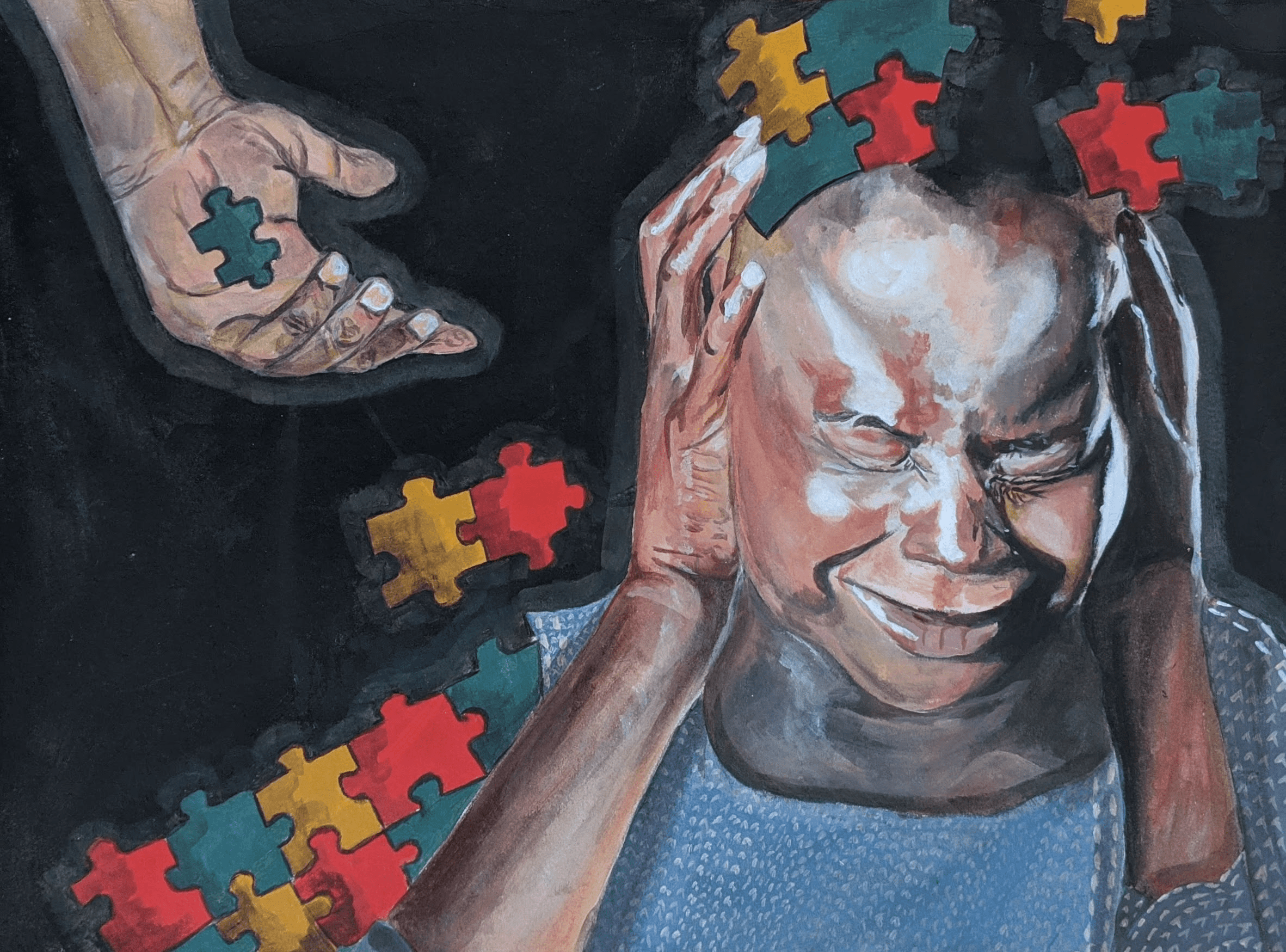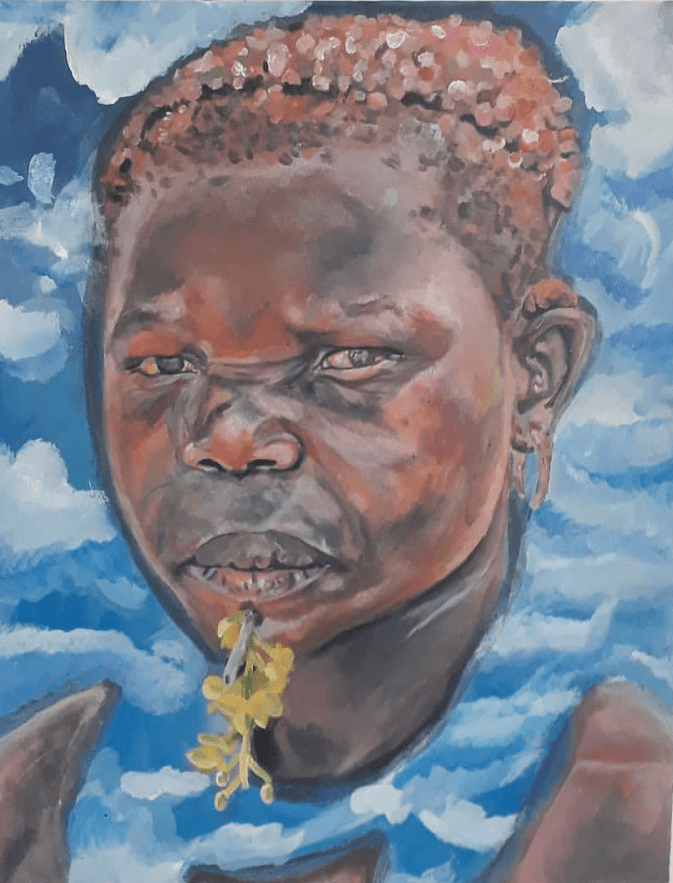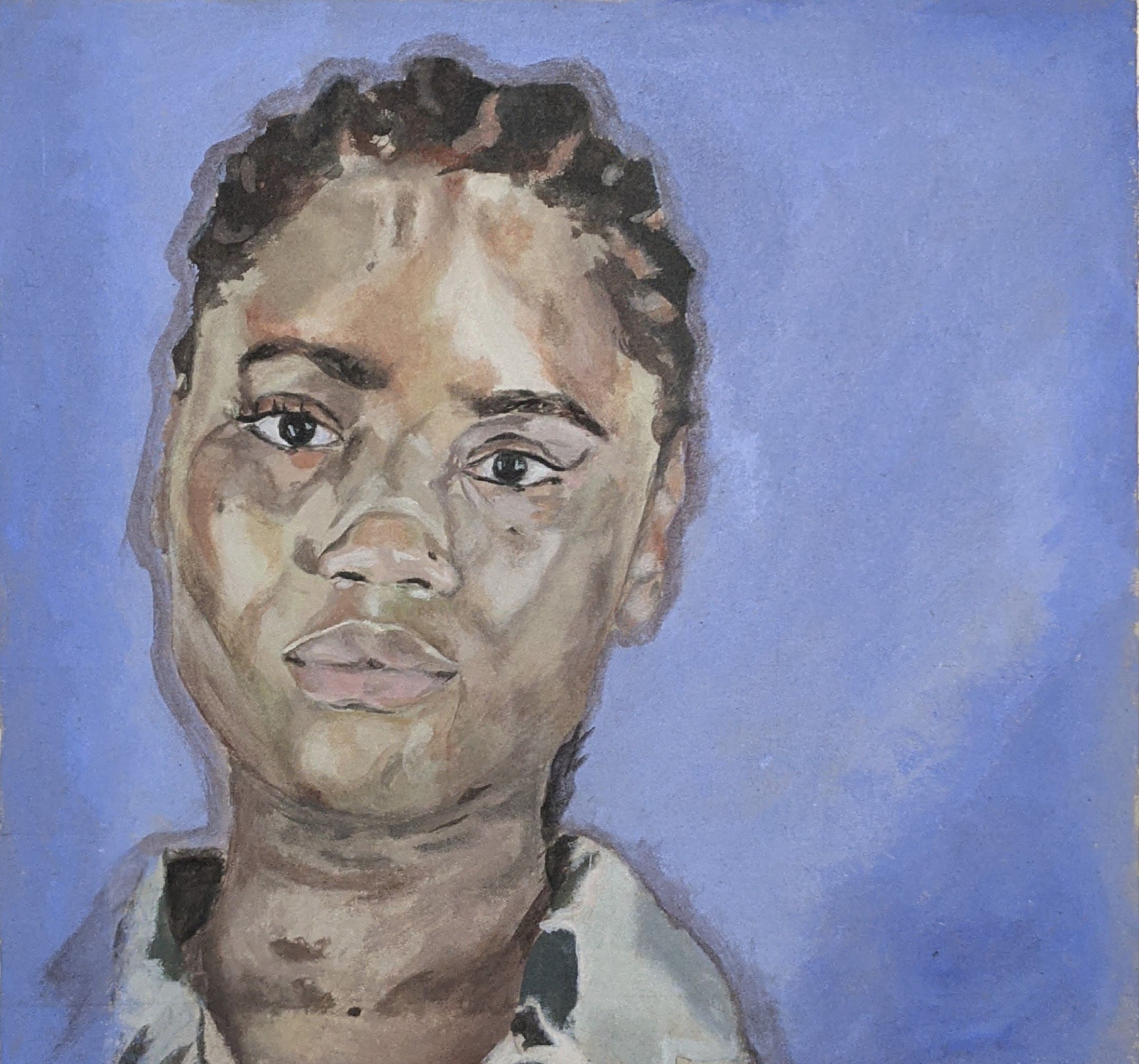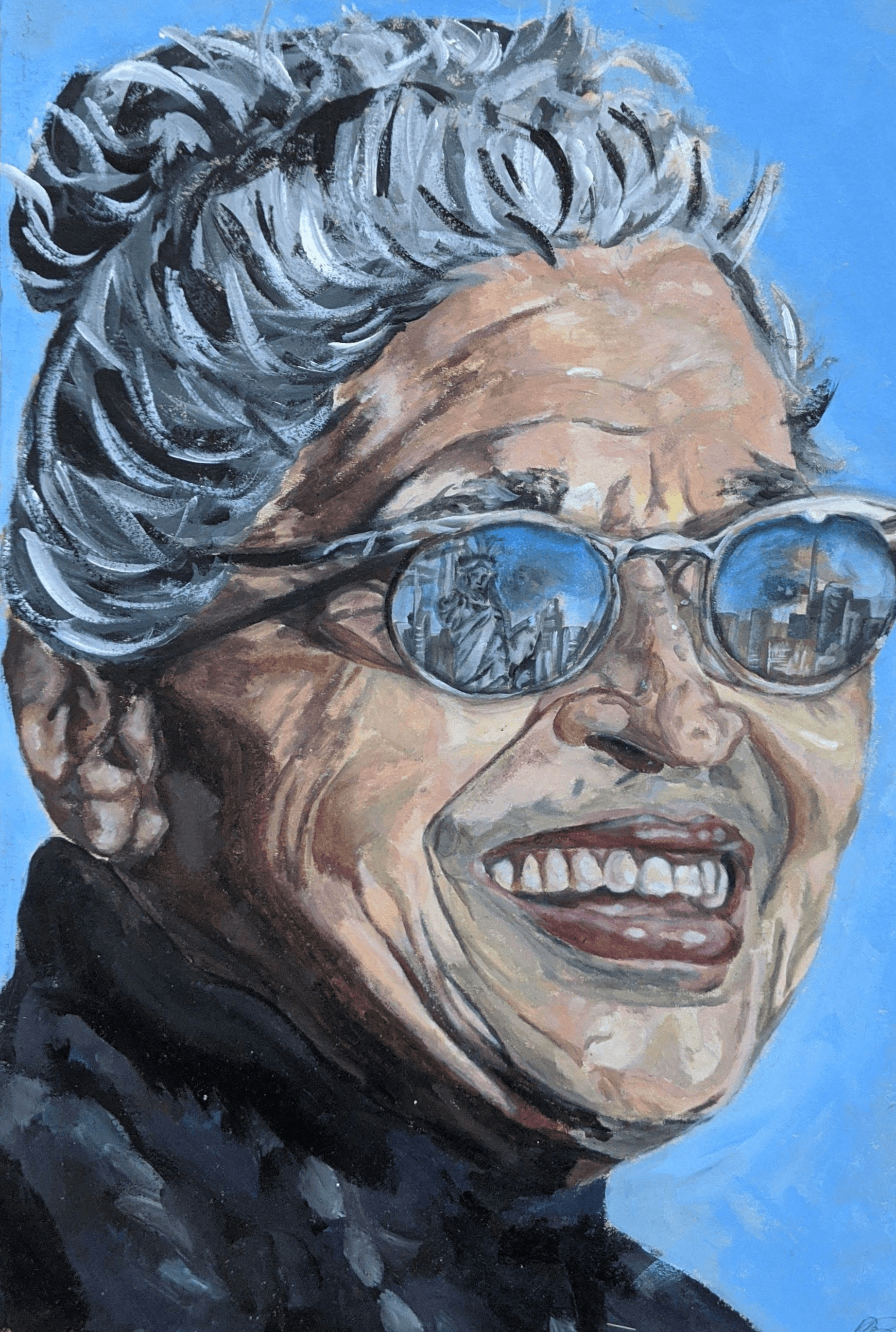Muna Aghamelu is a figurative artist working in the traditional practice with acrylics; exploring themes of heritage, history, and culture. Creating representations of Black portraiture, Muna is an artist who incorporates self-reflective introspection, cultural referencing, and education into her art. Aghamelu is also immersed in the tech industry and studying Computer Science, referencing coding to painting, she highlights how her studies influence her practice. I spoke with Muna to discuss the value of lived experiences in art, her influences, creative process, and healing through art during the socio-political climate.
NAHUEL CONTRERAS How did you begin your pursuit into art and what first drew you to acrylic painting? MUNA AGHAMELU When I was younger I’d always sketch things around me, or do the most when it came to anything creative such as cutting up my clothes in the name of ‘DIY’ or designing the front of my school planner. But I’d say I didn’t officially pursue art until I opted to do it for GCSE. By default I began painting with acrylics because that is what my school provided, I never really knew any other medium existed. So I guess I haven’t grown out of using acrylics, who knows I may switch to oils in the near future.
 NC
Who or what are your inspirations?
MA
Who, I’d say my family first and foremost; the values and lessons I learn from them have shaped a lot of the themes within my paintings. With regards to what, I’d say how people experience life. This may seem a bit broad, but I think one of the reasons that I love painting portraits is because I can understand and learn about the subject. Whether it be a historical event that affected a community, understanding what someone stood for, or understanding how people have tried to change or inspire those around them, I just love learning about ‘life’, and listening to others talk about how they navigate life.
NC
Thinking about reference points, influences and inspiration, you often depict prominent Black figures in your art. Where does the intention come from?
MA
Yes! This stems from when I first started painting; I had moved on from still life to portraiture, and after completing a self-portrait my art teacher told us we could choose to paint anyone. I didn’t want to do the general thing of choosing celebrities to paint; I wanted it to be much more than that. It was around this time that I was also becoming very interested and invested in learning about Black History and Black America. I decided I’d paint people from the past that I was inspired by, and as a way to learn more about them, as I would research before painting. I also discovered the works of Sara Golish and Tim Okumaru, and although these artists aren’t Black themselves, their work inspired me and made me think; wow they are out there creating work for us. You don’t see a lot of that when you Google famous paintings. I just wanted to paint people I could connect with.
NC
It is incredibly affirming to see representations of Black portraiture, what is your approach to painting the human form?
MA
This may be the slight perfectionist in me, but I’ll start with a ruler and calculator, and draw grid lines to make sure that I’ve scaled the reference photo to the size of card (grey board) that I’m using. After doing a sketch and shading some areas, I’ll begin to apply paint. I always begin with the eyes; I don’t know why I started painting in this way, maybe I thought it’d be the hardest thing to paint, which is a testament to how I handle a lot of things in life; start with the hardest thing and then work your way onto to the next.
NC
Who or what are your inspirations?
MA
Who, I’d say my family first and foremost; the values and lessons I learn from them have shaped a lot of the themes within my paintings. With regards to what, I’d say how people experience life. This may seem a bit broad, but I think one of the reasons that I love painting portraits is because I can understand and learn about the subject. Whether it be a historical event that affected a community, understanding what someone stood for, or understanding how people have tried to change or inspire those around them, I just love learning about ‘life’, and listening to others talk about how they navigate life.
NC
Thinking about reference points, influences and inspiration, you often depict prominent Black figures in your art. Where does the intention come from?
MA
Yes! This stems from when I first started painting; I had moved on from still life to portraiture, and after completing a self-portrait my art teacher told us we could choose to paint anyone. I didn’t want to do the general thing of choosing celebrities to paint; I wanted it to be much more than that. It was around this time that I was also becoming very interested and invested in learning about Black History and Black America. I decided I’d paint people from the past that I was inspired by, and as a way to learn more about them, as I would research before painting. I also discovered the works of Sara Golish and Tim Okumaru, and although these artists aren’t Black themselves, their work inspired me and made me think; wow they are out there creating work for us. You don’t see a lot of that when you Google famous paintings. I just wanted to paint people I could connect with.
NC
It is incredibly affirming to see representations of Black portraiture, what is your approach to painting the human form?
MA
This may be the slight perfectionist in me, but I’ll start with a ruler and calculator, and draw grid lines to make sure that I’ve scaled the reference photo to the size of card (grey board) that I’m using. After doing a sketch and shading some areas, I’ll begin to apply paint. I always begin with the eyes; I don’t know why I started painting in this way, maybe I thought it’d be the hardest thing to paint, which is a testament to how I handle a lot of things in life; start with the hardest thing and then work your way onto to the next. Once I’m done with the eyes, I work my way outwards. I don’t actually use a lot of paint; I just focus on the shadows of the image so that I’m able to create depth without overworking the piece. In my earlier work, I was more interested in making sure I get the exact shades and likeness of the human form, but now I think my strokes are very dependent on how I’m feeling. So you may notice some changes in my style.
 NC
Your art is deeply self-reflective, and proclaims the importance of introspection. Are you able to elaborate on how this affects the narrative of your paintings, and your creative process?
MA
Thank you, I’m happy my work comes across like that; I do think self-reflection is very important. Regarding the narrative, I just think painting allows me to explore things I wouldn’t normally. If you met me in person you’d think I always seem to be doing something to stay busy, but painting allows me to just pause and explore an idea I’ve had in mind that I’ve pushed back because of the busyness of living in a world that tells you if you don’t keep going you’ll fall behind. The older you get the more you realise your decisions and actions hold a lot more weight than they once did. So that’s why my creative process isn’t really setting stone, it’s actually quite sporadic. I create when I really need to I think. So that is why my narrative is just an extension of my inner self/thoughts.
NC
You speak candidly about insecurities, and how that impacts your art. During the current socio-political climate, how have you been able to manifest inspiration and motivation?
MA
It’s been really hard. I wouldn’t say that recent events have inspired or motivated me to create because that seems too positive; they kind of forced me to create because I needed an outlet. After painting ‘Surface Level’, I felt as though a weight had been lifted off my shoulder. I was just in such a chaotic state of mind, I had to take a break from social media, and I just didn’t know how to express myself.
NC
Your art is deeply self-reflective, and proclaims the importance of introspection. Are you able to elaborate on how this affects the narrative of your paintings, and your creative process?
MA
Thank you, I’m happy my work comes across like that; I do think self-reflection is very important. Regarding the narrative, I just think painting allows me to explore things I wouldn’t normally. If you met me in person you’d think I always seem to be doing something to stay busy, but painting allows me to just pause and explore an idea I’ve had in mind that I’ve pushed back because of the busyness of living in a world that tells you if you don’t keep going you’ll fall behind. The older you get the more you realise your decisions and actions hold a lot more weight than they once did. So that’s why my creative process isn’t really setting stone, it’s actually quite sporadic. I create when I really need to I think. So that is why my narrative is just an extension of my inner self/thoughts.
NC
You speak candidly about insecurities, and how that impacts your art. During the current socio-political climate, how have you been able to manifest inspiration and motivation?
MA
It’s been really hard. I wouldn’t say that recent events have inspired or motivated me to create because that seems too positive; they kind of forced me to create because I needed an outlet. After painting ‘Surface Level’, I felt as though a weight had been lifted off my shoulder. I was just in such a chaotic state of mind, I had to take a break from social media, and I just didn’t know how to express myself. I knew I couldn’t be the only one feeling that way, so although hesitant, I still decided to share the piece. ‘Gratitude’, another piece I created recently, was also a result of how I was learning to cope with the current socio-political climate, and I wanted to hopefully inspire others as well. Insecurities, we all have them, and I think there is beauty in that; they make us stronger, and the easiest way to understand yourself. I guess painting allows me to own that and grow from it. NC For your piece ‘Gratitude’, you photographed your sitters as a prerequisite to painting. Do you have a routine creative process when working? MA No, I have this idea in my head that I can be many things, a photographer, a video producer, an artist, a programmer, a researcher, a runner; you name it. So me choosing to photograph my sitters was playing on that idea. It was a spur of the moment thing; I planned out the whole photo shoot in my head and found images on pinterest for inspiration. But after doing it, it made me want to do it more. I have already planned out two other series that involve me taking photos beforehand; I’m just waiting for the world to go back to “normal”. So yeah, no fixed routine I just go off ideas that make me excited. NC You are very interactive with how you present your work; asking viewers to vocalise their interpretations and the feelings they elicit, and encouraging discussions via social media. Even the inclusion of benevolent quotes and curated music, which accompany the artworks, enhance the visual experience and provide inspiration. How viewers make sense of art in conversation may relate to their experiences and perception of the world. How do you incorporate your own experiences with the world – both past and present - into your art? MA My art is sometimes therapy for me. I’m able to make sense of my past and present experiences after I have come up with a painting that encapsulates a lot of my thoughts. This may be through symbolism, or the figures I choose to paint.
 NC
Perspectives within art are often shaped by cultural progressions throughout society. Technology is greatly impacting how we interact with and consume art. In you artist statement you mention that you are a Black woman entering the tech industry, how does this influence your practice?
MA
I’m currently studying a degree in Computer Science, and like any degree it takes a lot of time and commitment, so sometimes it’s hard to consistently create art. Immediately it may not seem like the most creative subject, but the thought that comes about from problem solving and coding up a solution is actually quite creative, you have to think outside of the box. I think this influences my practice because I always look beyond just painting, I always ask why and how.
NC
Perspectives within art are often shaped by cultural progressions throughout society. Technology is greatly impacting how we interact with and consume art. In you artist statement you mention that you are a Black woman entering the tech industry, how does this influence your practice?
MA
I’m currently studying a degree in Computer Science, and like any degree it takes a lot of time and commitment, so sometimes it’s hard to consistently create art. Immediately it may not seem like the most creative subject, but the thought that comes about from problem solving and coding up a solution is actually quite creative, you have to think outside of the box. I think this influences my practice because I always look beyond just painting, I always ask why and how. Also being a minority means it’s quite challenging, there aren’t enough of us in this industry. So I’m always trying to work hard, because I don’t want anything to stop me from breaking a glass ceiling. But creating art is also a form of defiance; it’s a reminder that I can still do the things that I love despite trying so hard. I hope by creating, I am breaking stereotypes and redefining of what it means to be a Black woman in tech. NC The painting ‘Floating Tribe’ from your Diaspora series depicts themes of aspiration and connection, emphasising your yearning to learn and explore your Igbo heritage. Could you elaborate on how cultural identity has greatly influenced the context of your paintings? MA A man who doesn’t know his history is a man without roots, I think that’s how the quote goes. Culture gives you a sense of belonging when you feel like you may not belong. Being Nigerian is such a beautiful thing, our music bangs, the food is *chef’s kiss* and the people are just energy. But being a Nigerian and living in the UK makes me think a lot about what it would’ve been like if I grew up in my home country. #EndSARS made me Google how you could become the president of Nigeria, just out of interest, and one of the requirements is being born in Nigeria. But back to the point, my most meaningful works of art are products of questioning my own identity.
 NC
In ‘Floating Tribe’, the clouds that replace the necklace to emphasis displacement highlight your ability to conceptualise your ideas abstractly. How do you define your artistic style?
MA
I’m still trying to figure this one out myself. I’d say a tablespoon of realism, a hint of emotion and symbolism, and a dollop of Blackness.
NC
Your painting, ‘Power’, from the series Stance, depicts the historic 1968 Olympics Black Power salute. Engaging in history and proclaiming archival moments are important to Black experiences and lineage in the diaspora. What is the significance of referencing archival elements within your work?
MA
To open conversations, and to encourage people to learn about history.
NC
Your painting ‘Malcolm’ is a discussion on Black experiences, including your own. Do you see your art as social commentary?
MA
I wouldn’t say so because that isn’t my intention, it’s more so creating from lived experiences. When I paint, I like others to have their own interpretations of my work so that they can form their own sense of judgement. Explaining the narrative and inspiration that lead me to create ‘Malcolm’ is just my way of expressing why I created it, but I’m now leaving it up to you on whether you want to understand it through my eyes, or form your own understanding of the piece. But creating art for the sole purpose of social commentary would be interesting.
NC
In ‘Floating Tribe’, the clouds that replace the necklace to emphasis displacement highlight your ability to conceptualise your ideas abstractly. How do you define your artistic style?
MA
I’m still trying to figure this one out myself. I’d say a tablespoon of realism, a hint of emotion and symbolism, and a dollop of Blackness.
NC
Your painting, ‘Power’, from the series Stance, depicts the historic 1968 Olympics Black Power salute. Engaging in history and proclaiming archival moments are important to Black experiences and lineage in the diaspora. What is the significance of referencing archival elements within your work?
MA
To open conversations, and to encourage people to learn about history.
NC
Your painting ‘Malcolm’ is a discussion on Black experiences, including your own. Do you see your art as social commentary?
MA
I wouldn’t say so because that isn’t my intention, it’s more so creating from lived experiences. When I paint, I like others to have their own interpretations of my work so that they can form their own sense of judgement. Explaining the narrative and inspiration that lead me to create ‘Malcolm’ is just my way of expressing why I created it, but I’m now leaving it up to you on whether you want to understand it through my eyes, or form your own understanding of the piece. But creating art for the sole purpose of social commentary would be interesting.
 NC
You discuss how your Diaspora series allowed you “to understand that growth isn't finite, being Black is complicated, and self-love is really just trying not to be so hard on yourself”. How do you work to establish a visual narrative that is an evocation of the importance of Black experiences within art?
MA
The art world is something I’ve only started recently understanding and learning about. I actually spoke to a friend a couple of weeks ago who studies art he and said he feels as though the art world is racist, and if you aren’t painting about Black oppression they don’t really want to hear about it. I guess by default, because my art is an extension of me, my art will be categorised as “Black art”.
NC
You discuss how your Diaspora series allowed you “to understand that growth isn't finite, being Black is complicated, and self-love is really just trying not to be so hard on yourself”. How do you work to establish a visual narrative that is an evocation of the importance of Black experiences within art?
MA
The art world is something I’ve only started recently understanding and learning about. I actually spoke to a friend a couple of weeks ago who studies art he and said he feels as though the art world is racist, and if you aren’t painting about Black oppression they don’t really want to hear about it. I guess by default, because my art is an extension of me, my art will be categorised as “Black art”. But why can’t it just be art? It just gives others a way of tokenising our work in the name of good faith. Black experiences are important within art because there is so much creativity that comes from Black culture, and we need others to understand life through our lens, it is only through empathy and understanding things can change. We deserve to be in the big museums, not because we’re Black, but because we created something beautiful.
So I think by just painting my truth, I'm able to establish that Black experiences are unique and colourful experiences, and should be celebrated more in art.
 NC
What’s coming up next for you and your work?
MA
For me, trying to learn to take each day as it comes. For my work, I’m currently working on a piece that will hopefully teach me patience and the importance of having a long-term goal. It’s also a product of me wanting to explore the idea of teaching through art, so allowing people to learn more about their culture through what I create. It may take me a year to complete, but there’s beauty in the process.
NC
What’s coming up next for you and your work?
MA
For me, trying to learn to take each day as it comes. For my work, I’m currently working on a piece that will hopefully teach me patience and the importance of having a long-term goal. It’s also a product of me wanting to explore the idea of teaching through art, so allowing people to learn more about their culture through what I create. It may take me a year to complete, but there’s beauty in the process.
